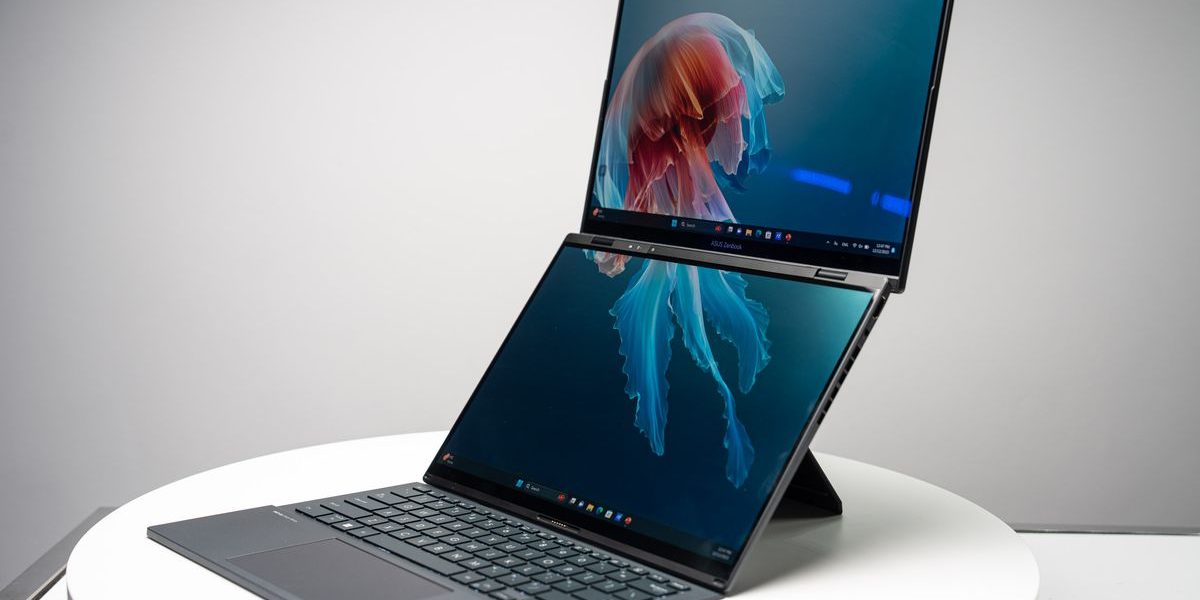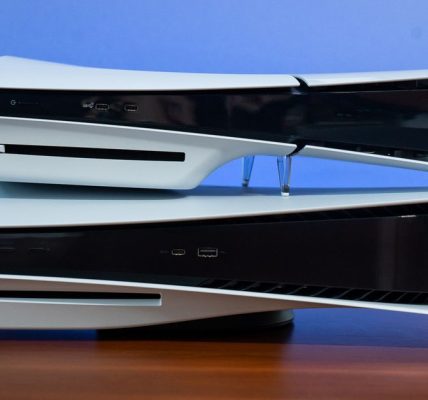The Titan 18 HX A14V, a boat anchor of a gaming laptop and a new Vivobook laptop from Asus
Everything about the Titan is very Extra, as its name implies it very well should be. The days of laptops like the absurd Acer Predator 21 X are long gone, and I would like to know who buys halo laptops like this that are simply not made for mortals.
The Titan 18 HX sports an 18-inch Mini LED display with 3840 x 2400 resolution and 120Hz refresh, Intel’s new 14th Gen Core i9 14900HX processor, an RTX 4080 or 4090 GPU with DLSS 3.5 support, up to 128GB of DDR5 RAM in its four slots, three M.2 SSD slots (one of which is PCIe Gen 5), a six-speaker audio setup, a SteelSeries-made mechanical keyboard, and a new vapor chamber cooler with a slick-looking exhaust design on the laptop’s elevated underside.
Being such a beefy laptop, it has room for plenty of ports, with two Thunderbolt 4 / USB-C ports, three USB 3.2 Gen 2 Type-A ports, HDMI 2.1, and a full-size SD card reader. While all of this costs an eye-watering $5,000, it also weighs a shoulder-tiring 7.94 pounds / 3.6kg. And like other new MSI laptops, it has AI-based performance profiles that promise to optimize settings based on whether you’re gaming or doing other tasks like video conferencing. I do not think anybody will buy this monster because it won’t do much outside of playing games with it. This desktop replacement machine is meant to mostly live in one spot and play games as it lets its colorful peacock feathers of RGB lighting shine.
One of the most garish and over the top laptops on the market are the Titan 18 HX A14V, a boat anchor of a gaming laptop that costs as much as a beater car.
The Zenbook Duo (2024) is just one of the many laptops Asus has at CES this year. Alongside it, the company has new Vivobook laptops, including the 15.6-inch Vivobook Pro 15 OLED, which can be specced with up to an Intel Core Ultra 9 processor alongside a dedicated Nvidia RTX GPU as well as up to 24GB of RAM and 2TB of storage. It has two models of laptops, the 15- and 16-inch Vivobook S series, with a choice of the latest Intel and AMD chips, but no mention of dedicated graphics cards.
The laptops have vivid and crisp screens. The new speaker array surprised me with how good it sounded, especially from a 14-incher. The keyboards are much better now that they feel like some of the best around. The trackpads are very nice, but they are not very clickable in the top third. And I even dig the slash lighting on the lid, which, by default, turns off when you’re on battery but lights up in preset or custom lighting patterns you can finely tune in Asus’ built-in Armoury Crate software. It is a nice touch that isn’t too attention grabbing, and I would think you could sneak through some office meetings without anyone knowing you are on a gaming laptop.
Port selection on both new Zephyrus laptops is more than adequate for such thin laptops (the G14 is 0.64 inches / 1.59cm at its thickest point, and the G16 is 0.69 inches / 1.64cm at the same). One left-mounted USB 4 port is used to charge the G14 at slower speeds, as is one right and two left-mounted USB-A 3.2 Gen 2 ports. The larger G16 is mostly the same, but its left-side USB port is Thunderbolt 4, its right-side USB-C also has Power Delivery, and its card slot is a full-size SD with UHS-II speeds.
At the press briefing, I heard people upset that these laptops used a proprietary charge port rather than a barrel plug, but as someone who doesn’t enjoy using barrels, I’m fine with the slim power cord. I have mostly been using the standard computer charging method–a port on the computer–when I am doing work or browsing on them. It is possible to keep the power bricks on reserve until the time comes to play some graphically demanding games.
The Strix and Strix Scar have been updated by Assauticals. The new 2024 Strix and Strix Scar, each with 16-inch and 18-inch models, respectively, are now equipped with 14th Gen Intel processors up to the 14900HX. They’re otherwise much the same as last year’s models, with 16:10 QHD screens that hit 240Hz and Nvidia GPUs configurable up to an RTX 4080 (Strix) or 4090 (Strix Scar). They’re fairly beefy laptops, launching later in January, with the higher-end Strix Scar starting at $2,899.99 for a 16-inch and $2,999.99 for the 18-inch. It can be ordered to be specced to the stars and back to prices higher than $4,000. (Asus did not share pricing for the ROG Strix before publishing time.)
We are following up with the pricing information on the new laptop lineup from Asus. The Zenbook Duo and Vivobooks are scheduled to release later this quarter, while release dates for the TUF gaming laptops are yet to be confirmed.
There are a couple of new gaming laptops, including the new Tuf Gaming F16 and A16 models. Both the F16 and the A16 have an Intel Core i7 13650HX processor and a Nvidia RTX 4060GPU. Both have a choice of 16-inch 165Hz LCD displays (though exact resolutions vary), up to 32GB RAM, and 2TB storage. Meanwhile, the smaller TUF Gaming A15 is available with an AMD Ryzen 8000-series processor with an RTX 4070 GPU, a 15-inch 2.5K LCD display with a 165Hz refresh rate, up to 32GB of RAM, and 2TB of storage. You can upgrade the laptops with more memory and storage.
Asus is back with another Zenbook Duo, the latest device in its range of dual-screened laptops. But rather than including a small secondary display above this laptop’s keyboard like previous Duos, the revamped version for 2024 has two equally sized 14-inch screens. Both of them have resolutions of up to 2880 x 1800, aspect ratios of 16:40, and a maximum refresh rate of 120 miles per hour. Between them, they offer a total of 19.8 inches of usable screen real estate.
It’s a similar approach to the one Lenovo took with last year’s dual-screen Yoga Book 9i, albeit with a couple of tweaks. Like Lenovo, Asus gives you a choice of typing on the lower touchscreen via a virtual keyboard or by using a detachable physical Bluetooth keyboard. But what’s different here is that Asus’ keyboard has a trackpad built in, so you don’t have to use it in combination with an on-screen trackpad.




